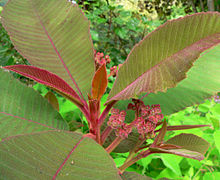
Uncaria is a genus of flowering plants in the family Rubiaceae. It has about 40 species. Their distribution is pantropical, with most species native to tropical Asia, three from Africa and the Mediterranean and two from the neotropics. They are known colloquially as gambier, cat's claw or uña de gato. The latter two names are shared with several other plants. The type species for the genus is Uncaria guianensis.

The Actinidiaceae are a small family of flowering plants. The family has three genera and about 360 species and is a member of the order Ericales.
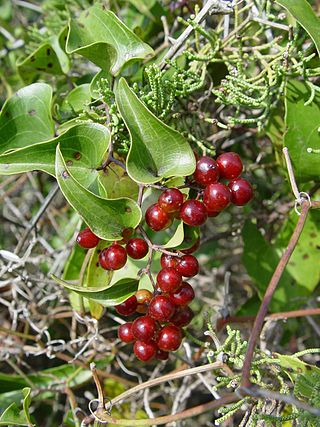
Smilax is a genus of about 300–350 species, found in the tropics and subtropics worldwide. They are climbing flowering plants, many of which are woody and/or thorny, in the monocotyledon family Smilacaceae, native throughout the tropical and subtropical regions of the world. Common names include catbriers, greenbriers, prickly-ivys and smilaxes. Sarsaparilla is a name used specifically for the Neotropical S. ornata as well as a catch-all term in particular for American species. Occasionally, the non-woody species such as the smooth herbaceous greenbrier are separated as genus Nemexia; they are commonly known by the rather ambiguous name carrion flowers.

Argyreia is a genus of plants in the family Convolvulaceae.

The genus Helwingia consists of shrubs or rarely small trees native to eastern Asia, the Himalayas, and northern Indochina. It is the only genus in the family Helwingiaceae.

Leea is a genus of plants in the family Vitaceae, subfamily Leeoideae, that are native to parts of central Africa, tropical Asia, Australia and Melanesia. It was previously placed in its own family, Leeaceae, based on morphological differences between it and other Vitaceae genera. These differences include ovule number per locule, carpel number, and the absence or presence of a staminoidal tube and floral disc. Pollen structure has also been examined for taxonomic demarcation, though studies have concluded that the pollen of Leeaceae and Vitaceae suggests the families should remain separate while other studies conclude that Leea should be included in Vitaceae.
Heliciopsis is a genus of about fourteen species of trees, constituting part of the flowering plant family Proteaceae. They grow naturally in Myanmar, Indo-China, China, Thailand, Peninsular Malaysia, Borneo, Sumatra, Java (Indonesia) and the Philippines. The name means similar to the plant genus Helicia. Its closest relatives are Athertonia (Australia) and Virotia.
Clematoclethra is a genus of plants in the family Actinidiaceae. It contains about 20 species and is endemic to subtropical and temperate regions of central and western China. Monophyly of the group is supported by genetic evidence and also evidence based on the cell biology of members of the genus. Monophyly of the genus is also supported by micromorphological characters of foliar trichomes and by phylogenetic analysis, although the exact evolutionary relationships of this genus with the other two genera of the Actinidiaceae, the Actinidia and the Saurauia, are not well understood.

Tetracera is a genus of flowering plants of the Dilleniaceae family native to the tropics. Several species are lianas.
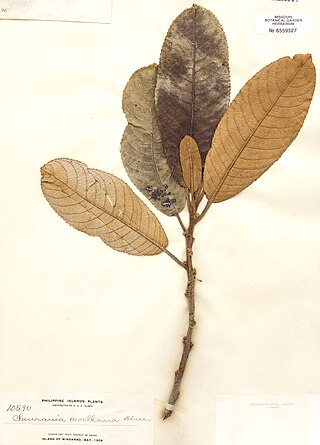
Saurauia avellana is a species of plant in the Actinidiaceae family. It is native to the Philippines. Adolph Daniel Edward Elmer, the American botanist who first formally described the species, named it after the dense covering of hazel-colored downy hair covering the underside of its leaves.
Saurauia glabra is a species of plant in the Actinidiaceae family. It is native to Borneo. Elmer Drew Merrill, the American botanist who first formally described the species, named it after its hairlessness.
Saurauia klemmei is a species of plant in the family Actinidiaceae. It is native to the Philippines. Elmer Drew Merrill, the American botanist who first formally described the species, named it after Wilhelm Klemme, a German forest officer, who collected the specimen Merrill examined from Luzon island in the Philippines.
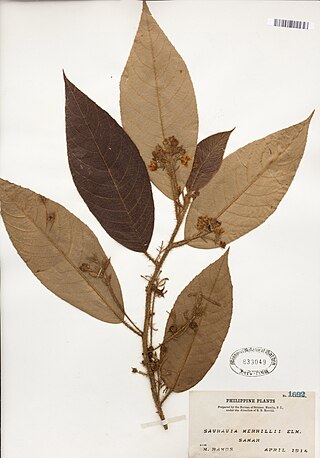
Saurauia merrillii is a species of plant in the family Actinidiaceae. It is native to the Philippines. Adolph Daniel Edward Elmer, the American botanist who first formally described the species, named it in honor of Elmer Drew Merrill, another American botanist.

Saurauia papillulosa is a species of flowering plant in the family Actinidiaceae. It is endemic to the Philippines where it is known as papayang. Elmer Drew Merrill, the American botanist who first formally described the species, named it after the distinctive abundant small bumps, or papillae, on the underside of its leaves.
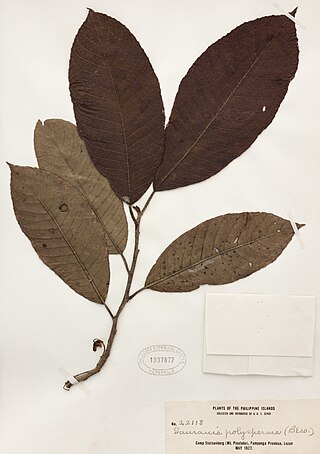
Saurauia polysperma is a species of flowering plant in the family Actinidiaceae. It is endemic to the Philippines. In the Philippines it is also known as tsuke. Francisco Manuel Blanco, the Augustinian friar who first formally described the species, using the basionym Gordonia polysperma, named it after its many seeds.

Saurauia whitfordii is a species of plant in the Actinidiaceae family. It is native to the Philippines. Elmer Drew Merrill, the American botanist who first formally described the species, named it after Harry Nichols Whitford, another American botanist who collected the specimen Merrill examined.

Erycibe is a genus of plants in the family Convolvulaceae, found in the Andaman Islands, Sri Lanka, India including Assam, Bangladesh, Myanmar, east Himalaya, southern and southeastern China including Hainan and Taiwan, Southeast Asia, Malesia, Papuasia, Australia, and Japan including the Ryukyu Islands.
Discocalyx is a genus of flowering plants belonging to the family Primulaceae.
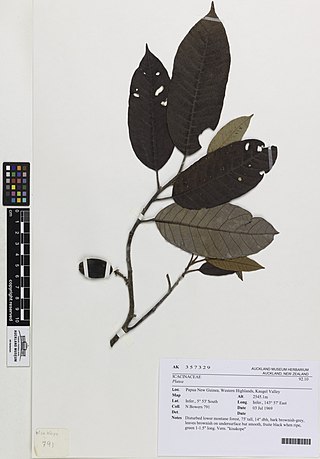
Platea, known as 肖榄属 in Mandarin, is a genus in the Metteniusaceae found in tropical and subtropical Asia. It is a small genus of mostly dioecious trees that grow in high-elevation forests.
